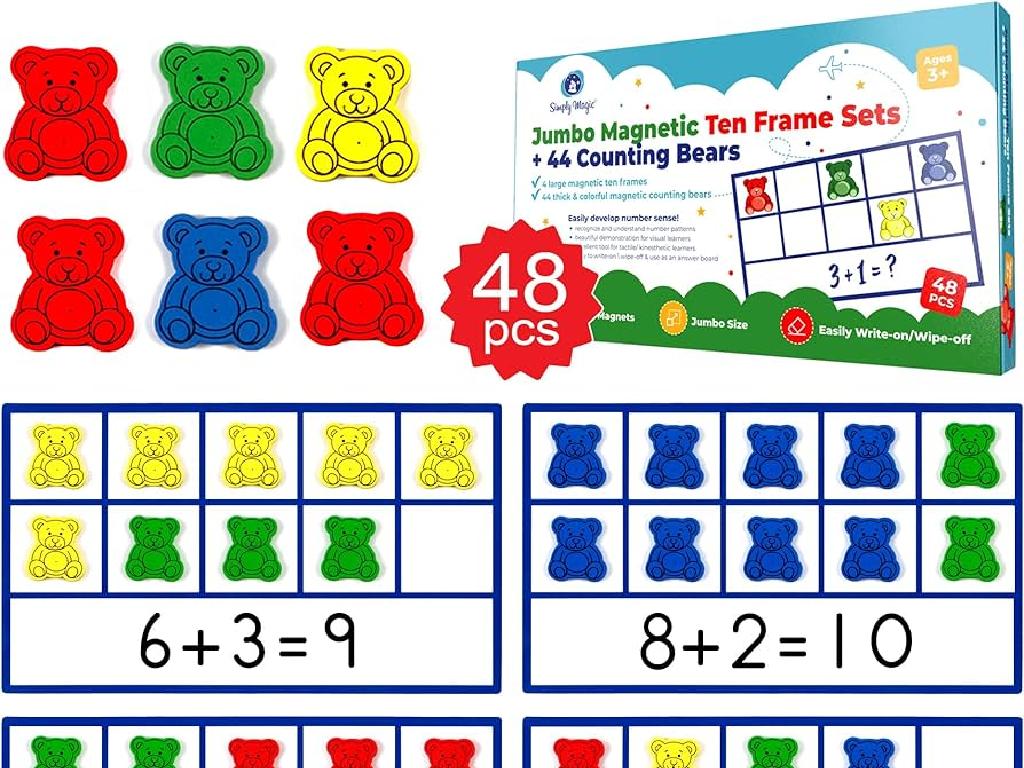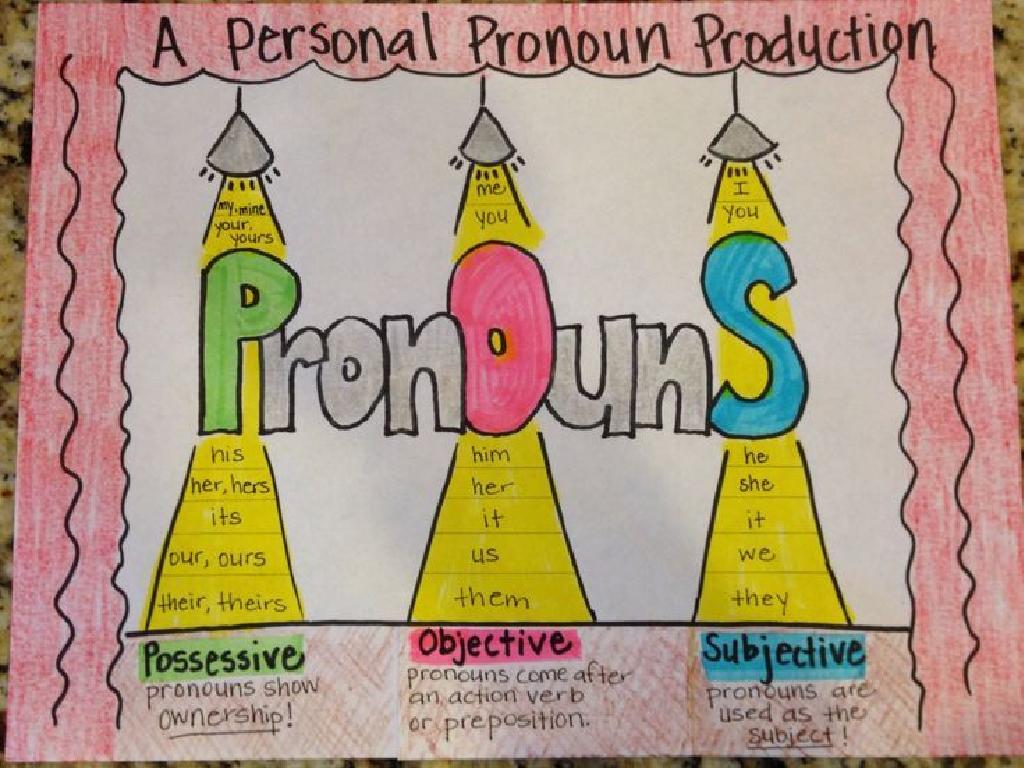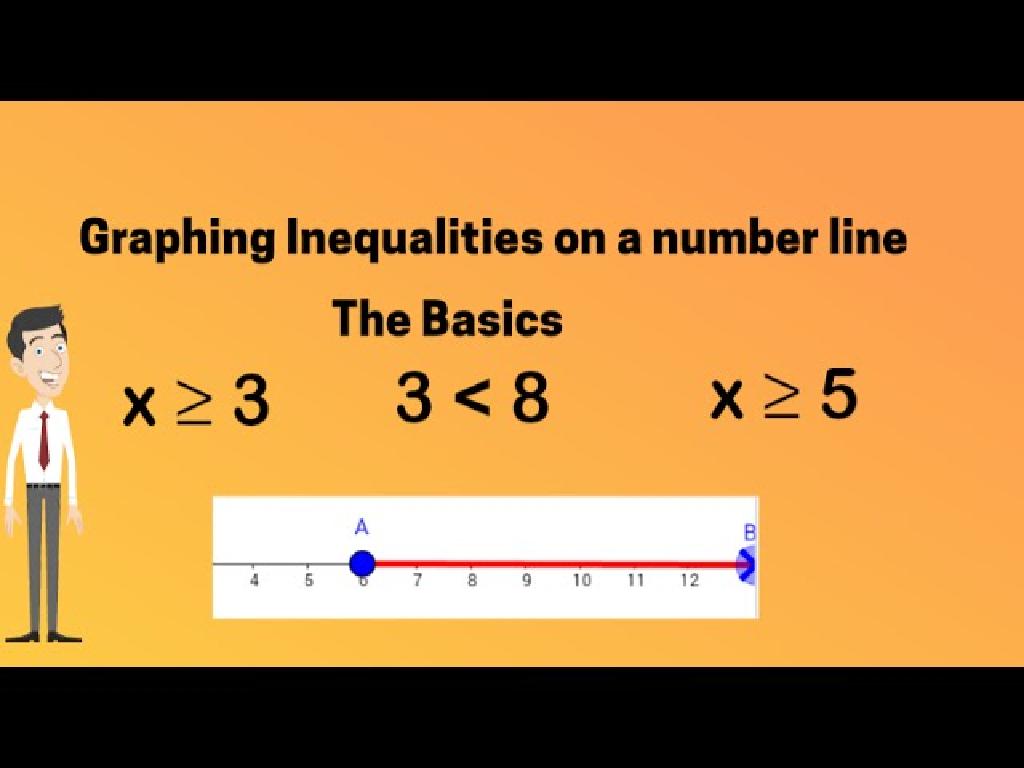Make Halves And Fourths
Subject: Math
Grade: First grade
Topic: Fractions
Please LOG IN to download the presentation. Access is available to registered users only.
View More Content
Welcome to Fractions: Halves and Fourths
– Learn about halves and fourths
– Splitting something into 2 equal parts makes halves
– Understand parts of a whole
– Splitting something into 4 equal parts makes fourths
– Fun examples: pizza and apples
– Imagine cutting a pizza or an apple into equal pieces
– Practice making halves and fourths
– We’ll draw and cut out shapes to see how it works
|
This slide introduces first graders to the concept of fractions, specifically halves and fourths. Start by explaining that a fraction represents a part of a whole. Use tangible examples like pizza and apples, which can be physically cut into equal parts, to illustrate the concept of halves (two equal parts) and fourths (four equal parts). Engage the students with hands-on activities such as drawing shapes and dividing them into halves and fourths, or using paper cut-outs to simulate cutting food items into equal parts. This will help them visualize and better understand the idea of fractions in a fun and interactive way.
Understanding Halves
– Cutting into 2 equal parts
– Each part is called a half
– One half is one out of the two equal parts of a whole item.
– Halves make up a whole
– Let’s cut a circle into halves!
– We’ll use scissors to cut a paper circle into 2 equal pieces.
|
This slide introduces the concept of halves to first graders. Begin by explaining that when an object is cut into two equal parts, each part is called a half. Emphasize the idea of equality in size of the two parts. Use visual aids like a paper circle to demonstrate cutting it into two equal pieces. Encourage students to think of other objects that can be divided into halves. As an activity, provide paper circles and safe scissors for students to practice cutting them into halves. Discuss why each piece is called a half and how two halves fit together to make a whole. This hands-on activity will help solidify their understanding of halves as a fundamental concept of fractions.
Understanding Halves in Our World
– Seeing halves around us
– Sharing a sandwich
– When you split it evenly, each person gets a half.
– Folding paper into halves
– Use paper to make visual halves.
– Practice makes perfect!
|
This slide is aimed at helping first graders recognize and understand the concept of halves in a tangible and relatable way. Start by discussing how we often see halves in our daily lives, such as when we share food. Use the example of sharing a sandwich to illustrate the concept of dividing something into two equal parts, each being a half. Move on to a hands-on activity where students can fold different shapes of paper to visually see and create halves. This kinesthetic approach reinforces the concept. Encourage students to think of other examples of halves and to practice making halves with various objects. The goal is for students to be able to identify and make halves confidently.
Understanding Fourths
– Fourths: Cutting into 4 equal parts
– Each part is 1 of the 4 equal parts
– Fourths are one quarter of a whole
– Let’s practice cutting into fourths!
– We’ll use scissors to cut a paper square into 4 equal pieces.
|
This slide introduces the concept of ‘fourths’ to first graders. Begin by explaining that when an object is divided into four equal parts, each part is called a ‘fourth’ or a ‘quarter.’ Use visual aids like a paper square or a pie to demonstrate this concept. Show them that each fourth is exactly one quarter of the whole item. For the activity, provide each student with a square piece of paper and guide them through the process of folding it in half and then in half again to create four equal sections. Then, have them cut along the folds to create four equal parts. Emphasize that all parts must be the same size to be considered ‘fourths.’ This hands-on activity will help solidify their understanding of the fraction one-fourth.
Understanding Fourths in Fractions
– Fourths in daily life
– See how items can be divided into 4 equal parts
– Pizza example: 4 equal pieces
– Each piece of the pizza is one fourth (1/4)
– Practice drawing fourths
– Use pictures to divide into 4 equal sections
|
This slide aims to help first graders visualize the concept of fourths using relatable examples. Begin by discussing how many items can be split into four equal parts, such as a pizza or a chocolate bar. Use the pizza example to show that when it’s cut into 4 equal slices, each slice represents one fourth, and all slices together make a whole. For the practice activity, provide pictures that students can draw lines on to divide them into fourths, reinforcing the idea of equal parts. Encourage students to think of other examples of fourths and share them with the class. This will help solidify their understanding of fractions in a fun and interactive way.
Making Halves and Fourths with Paper
– Fold paper to make halves
– Take a sheet of paper and fold it down the middle.
– Fold again to make fourths
– Now fold the half in two to see fourths.
– See how halves become fourths
– Understand that two fourths make a half.
– Activity: Fold, cut, color paper
|
This slide introduces the concept of fractions, specifically halves and fourths, using a hands-on paper folding activity. Start by demonstrating how to fold a piece of paper in half, and then in half again to create fourths. Explain that each fold reduces the size of the original paper by half, visually showing the relationship between halves and fourths. For the activity, guide the students to fold their own paper, cut along the folds to create separate pieces, and then color each part to reinforce the concept. This tactile experience helps solidify their understanding of fractions as parts of a whole. Prepare to assist students who may have difficulty with folding or cutting, and ensure everyone understands the concept before moving on.
Fun with Fractions: Halves and Fourths
– Play a game to find halves & fourths
– Match objects to fraction pieces
– Like puzzle pieces that fit together
– Group activity: divide items
– Look for items that can be split evenly
– Share your halves and fourths
– Show and tell with your divided items
|
This slide introduces a fun, interactive game to help first graders understand the concept of halves and fourths. Begin with a simple explanation of fractions, using visual aids like shapes or objects that can be physically divided. For the matching game, provide objects and cards representing their halves and fourths, and let students match them. In the group activity, encourage students to find items in the classroom that can be divided into equal parts. Each group can then present their items, explaining how they divided them into halves and fourths. This hands-on approach reinforces the concept of fractions in a tangible and engaging way.
Class Activity: Fraction Feast
– ‘Fraction Feast’ with play food
– Cut food into halves and fourths
– Use safe scissors to split play food items into 2 and 4 equal pieces
– Share ‘food’ to make equal parts
– Ensure everyone has a turn to split and share play food
– Discuss what we learned
– Talk about the activity and what it teaches us about fractions
|
This interactive class activity is designed to help first graders understand the concept of halves and fourths through a ‘Fraction Feast.’ Provide a variety of play food items and safe scissors. Students will practice their cutting skills by dividing the food into equal parts, reinforcing the idea of fractions as parts of a whole. Encourage them to share equally with classmates to further illustrate the concept. After the activity, facilitate a discussion about what they did and what they learned, emphasizing the real-life application of fractions in sharing and dividing things evenly. Possible variations of the activity could include using play dough to model food, drawing pictures of food to cut, or using paper plates divided into sections.
Review and Goodbye!
– Recap: Learning about halves and fourths
– We learned to split things into 2 equal parts (halves) and 4 equal parts (fourths).
– Finding halves and fourths around us
– Can you spot objects in the classroom that can be divided into halves or fourths?
– Praising the great work done today
– Looking forward to more math adventures
|
This slide is meant to wrap up the lesson on halves and fourths. Start by asking the students to summarize what they’ve learned about dividing objects into equal parts. Encourage them to look around the classroom for real-life examples of halves and fourths, such as a clock (divided into 4 quarters) or a sandwich cut into 2 equal parts. Praise their efforts and participation to boost their confidence. Let them know that their learning journey will continue and that there’s much more to explore in math. This positive reinforcement helps in making them look forward to future lessons.






